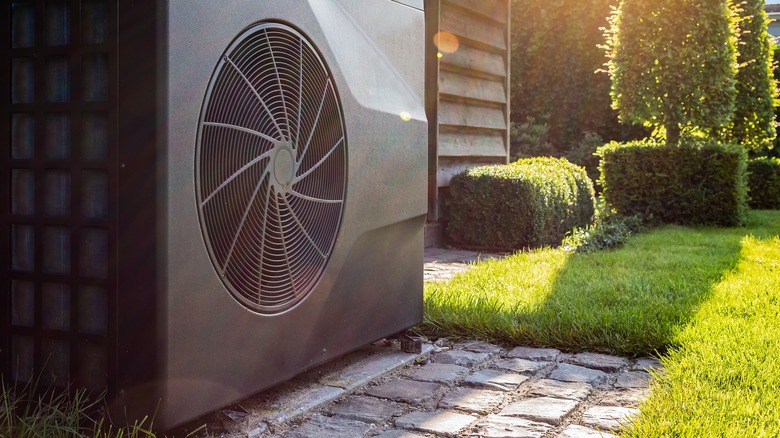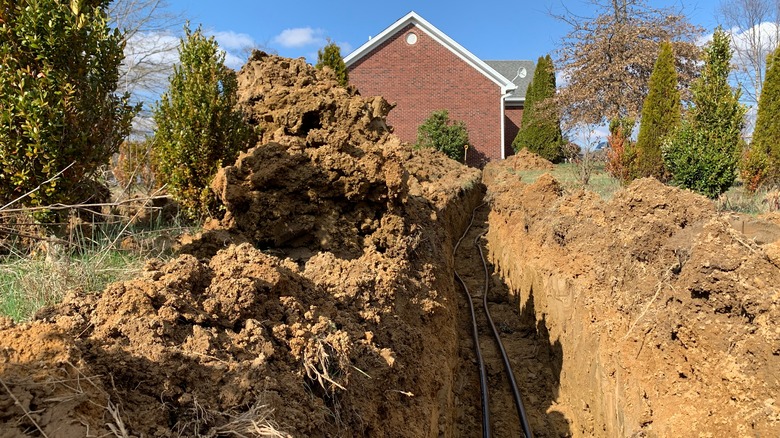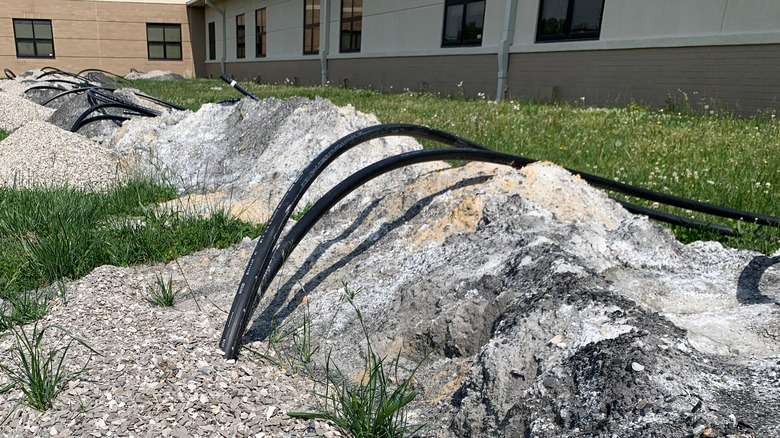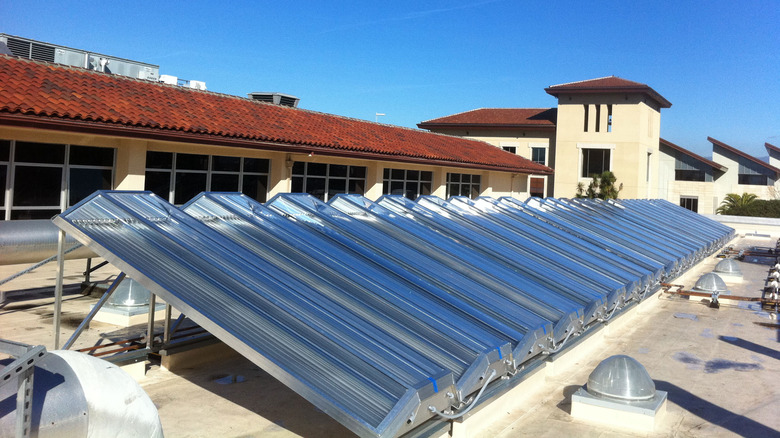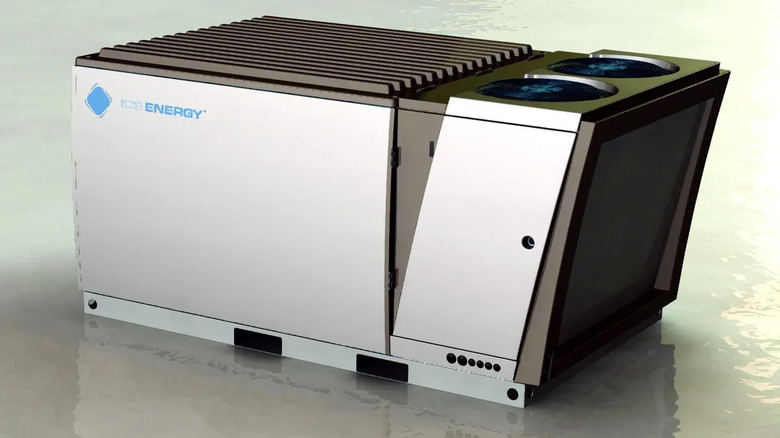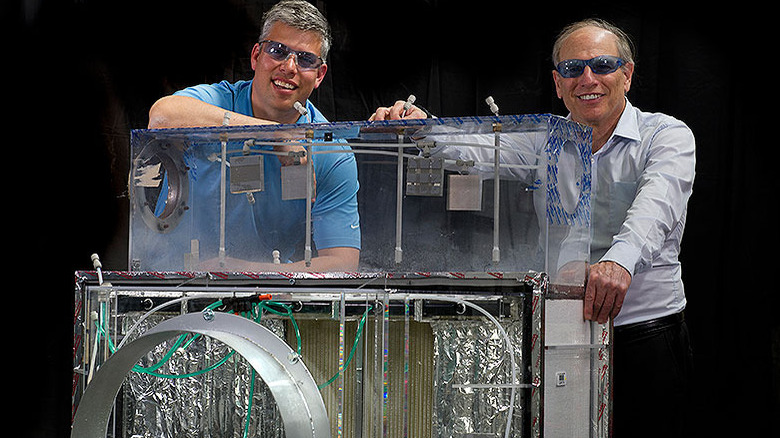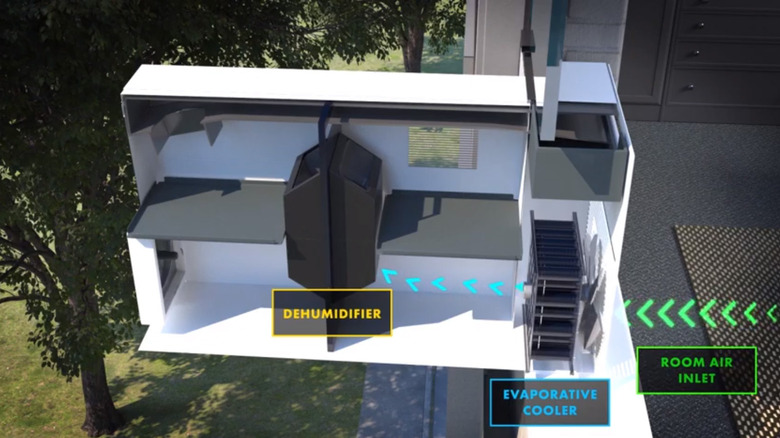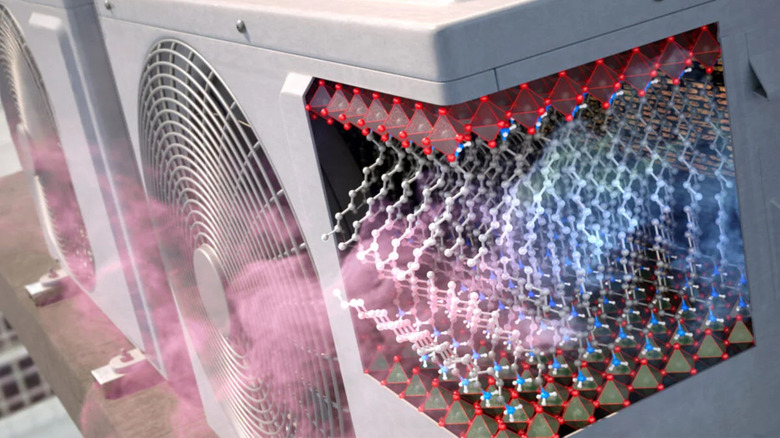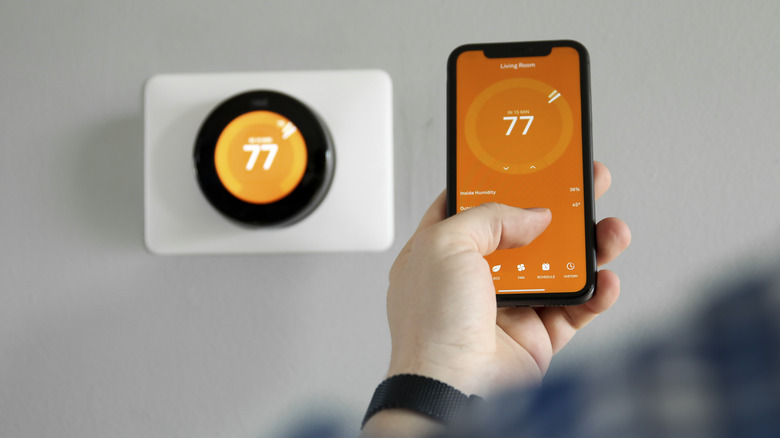New Air Conditioning Technologies That Could Be Coming To Your Home Soon
You've been paying a fortune to air condition your house during heat waves, or you might find that you prematurely need a new air conditioning unit because yours has been overworked. Many people, from environmental researchers to manufacturing engineers, are perpetually looking for a better way to cool homes — and for good reason. According to the International Energy Agency, the global demand for energy to power air conditioning is rapidly growing. As the agency's executive director Dr. Fatih Birol discusses the growing usage explaining, "With rising incomes, air conditioner ownership will skyrocket, especially in the emerging world. While this will bring extra comfort and improve daily lives, it is essential that efficiency performance for ACs be prioritized."
Cheaper, more environmentally friendly cooling will become more essential over the coming decades. While efficiency regulation might pave the way, it's innovation that will move us down the road. Thanks to technology and ingenuity, these are some groundbreaking air conditioning revolutions that could be coming to your home in the near future.
Dual-fuel heat pumps
Of course, solutions don't always come in the form of revolution, and air conditioning has steadily grown more efficient from its earliest days. Until the new visions of the innovators are realized, we'll continue to see current technologies like dual-fuel heat pumps improve. According to PV Heating & Air, the idea of dual-fuel systems is to heat your home using electricity during milder weather. This option is lower cost and can be adequate when the temperature is over 40 degrees. The system then switches to a furnace powered by another source, often natural gas, when it gets drastically cold outside and it needs more robust temperature control.
Lots of factors make the dual-fuel approach less than ideal for most people. Dual-fuel heat pumps also cool, but don't adjust the power source for cooling as they do for heating, so there's no real efficiency gain there. More efficient electric heat pumps, and the cost of having natural gas or propane installed, all make dual-fuel less attractive in milder climates. Not to mention, the cost of adding the hybrid system alone is $7,234 on average for homes with existing ductwork (via CostHelper).
Geothermal heat pumps
If you're familiar with them, you might think geothermal heat pumps are the sort of bleeding-edge high-tech wizardry that might never become a useful thing. But that's wrong on both counts. Geothermal technology isn't much different in concept from an old-school root cellar, and according to the Department of Energy, about 50,000 geothermal heat pumps are installed in the U.S. each year. Geothermal, or ground-source, heat pumps exchange heat from the ground with a medium like water or an antifreeze solution to drive indoor heating and cooling. This works because below-ground temperatures remain fairly constant, regardless of enormous differences in temperature above the surface (via Cielo).
Geothermal systems have a lot of benefits, like their durability, low maintenance costs, and unobtrusive workings. The key factor is that they are more efficient than dual-fuel systems. They even use less electricity if you invest in a system that also provides geothermal-preheated hot water for your home. But there are some downsides as well. Having a system installed can be a big investment, though this is usually recouped within six to seven years.
Water-source heat pumps
If you can leverage the earth's tendency to resist temperature change in order to build a better heat pump, would it be outrageous to think you could use water to do the same thing? Turns out, water-source heat pumps are already a thing and a good thing at that. Water-source heat pumps are actually a type of geothermal heat pump. Keep in mind that all heat pumps also provide cooling so it's more useful to use the terms ground-source heat pump and water-source heat pump to distinguish between them.
In a water-source system, as you might have guessed, heat is exchanged with a nearby body of water, the depths of which tend to remain at a near-constant temperature just as ground temperatures do, according to Cielo. This is done via a network of pipe coils that capture the heat in water or a refrigerant. This has all the environmental and cost-saving benefits of ground-source heat pumps, but some downsides as well. Of course, water-source heat pumps are only viable for people who live near, and have legal access to, a water source. Cheaper than ground-source systems because no digging is required, water-source systems are still more expensive than air-to-air systems.
Ductless mini-split heat pumps
You've seen ductless mini-splits, and perhaps you even understand that they're a great way to air condition spaces that can't easily be retrofitted with ducts. But the lowly mini-split has a lot of benefits and uses and probably should be even more common than they are. These air conditioners are composed of two units, an outdoor compressor and an indoor air handler with which the user interacts, says Comfort Up. They are used for both heating and cooling and are sometimes confused with the Packaged Terminal Air Conditioner (PTAC) systems seen in hotel rooms, though mini-splits are becoming more common there as well. PTACs are single-unit systems that work through a wall and are less efficient than mini-splits.
Ductless mini-splits are very flexible and have some significant benefits. First of all, they can be installed where ductwork doesn't exist. They are great for zoning, when individual rooms or areas are heated and cooled to different levels. And they tend to have very high SEER ratings, in part because ductwork can be responsible for as much as 30 percent of the energy used by air conditioning units (via the U.S. Department of Energy). They tend to result in improved indoor air quality, and are fairly easy to install (via WilmingtonBiz Insights). Proper system design is crucial to the efficient use of mini-splits, in order to avoid inefficient interactions among the systems like short-cycling.
Absorption refrigeration and solar cooling
Unlike these reasonably mature technologies, some emerging HVAC technologies have barely begun to emerge at all. This isn't always because they're new. Sometimes it's because there's a technical barrier holding up progress, and sometimes it's just a matter of the right person finally looking at the problem from the right angle to find a solution. But they hold such promise as a component of an improved heating and air conditioning technology that they shouldn't be disregarded just because their current states aren't ideal.
So it is with absorption refrigeration, which comes to HVAC systems via the ordinary solar panel. Except it's not really an ordinary solar panel at all. Absorption refrigeration uses thermally driven chillers, which use concentrating solar panels (CSP) rather than common photovoltaic (PV) solar panels. But traditional PV panels are still efficient at driving older vapor-compression technology, according to an American Society of Heating, Refrigerating and Air-Conditioning Engineers report.
CSP devices focus sunlight and thereby produce the far higher temperatures required by absorption refrigeration chillers to produce cold water and cold air. The solar collection can be supplemented by natural gas. Improved CSP devices like Chromasun's MCT-HT panels are making this technology practical, and real-world uses such as at Santa Clara University and the Abu Dhabi Distribution Company show that the technology is mature enough to start receiving some serious attention.
Ice-powered A/C
If you asked a classroom full of first-graders to devise an air conditioning system, it might look like the technology that's been pushed with middling success in California since the early 2000s. But a mediocre track record doesn't always indicate a mediocre idea. It's possible that this seemingly simple idea might be potentially successful in the future.
Ice-powered air conditioning, pioneered by a company called Ice Energy, creates a large block of ice at night and uses it to cool a building for part or all of the following day. Although the most recent iterations required supplemental AC and large amounts of water, Ice Energy secured contracts with Southern California Edison to implement the technology (via CleanTechnica). Unfortunately, Ice Energy filed for bankruptcy in 2019 and its products are not currently available. But the tech remains promising because it promises to use far less energy during the hottest periods. A Tennessee installation evaluated by the Electric Power Research Institute met Ice Energy's claims. EPRI says the technology would be ideal for residential applications and light commercial office space.
DEVap air conditioning
In 2019, a YouTube channel called Tech Ingredients released an engineering-heavy video called "Revolutionary Air Conditioner!" It demonstrated the building of a desiccant-based evaporative cooling system that, the video claimed, was twice as efficient as traditional AC. The technology itself was nothing new, though. A 2011 report by the National Renewable Energy Laboratory (NREL) discussed a version of the technology, which it found could reduce energy expenses 29-66% in new construction. However, this was based on modeling and prototypes have shown up to a 90% savings in practice. The report also discusses at length some concerns that would have to be addressed for the product to become commercially viable.
Many leading-edge HVAC technologies are simply older technologies with a twist, and that twist is often mashing up one half-baked tech with another to get something that's quite fully baked. Desiccant-enhanced evaporative air conditioners seek to overcome the limitations of fledgling evaporative cooling and desiccant-based dehumidification by having them work together. A company called Transaera was a finalist in the 2018-21 Global Cooling Prize competition with a similar concept that made use of a proprietary desiccant and a means of drying the desiccant using the system's own exhaust.
Evaporative cooling hybrids
Combination with desiccants apparently isn't the only way to re-engineer evaporative cooling to make it work better. Several of the most promising evolving cooling concepts have the potential to radically overhaul the HVAC market and, in the process, do wonders for the environment. Four such projects were also finalists in the Global Cooling Prize, including Gree, one of the two winners.
These included Indian company Godrej's project to merge standard and evaporative cooling technologies to reduce AC energy costs by as much as 80%, and Kraton's NexarCool concept in which a refrigerant-free evaporative cooling technology that uses the company's Nexar membrane to dehumidify air. This was similar to finalist M2 Thermal Solutions' low-energy, membrane-based evaporative cooling and dehumidification technology. Winner Gree's project was perhaps the ultimate mashup, integrating vapor compression, PV solar tech, evaporative cooling, and ventilation. The Gree entry was noted for its efficiency in making use of renewable and cheap cooling.
Barocaloric cooling technology
It takes a particular kind of genius to look at a problem in a new way by tweaking what appears to be an un-tweakable aspect. What would happen, you might wonder, if you take a particularly dry recipe and rather than making it wetter, you add another solid, like butter or coconut oil, to it? This isn't altogether unlike what is being done by scientists using a technology that is called barocaloric cooling, says Cooling Post.
This tech is similar to ordinary vapor-compression air conditioning, except that it uses solids rather than gasses to do its work. The system makes use of pressure to create solid-to-solid phase changes in which the molecular arrangement within the solid transforms without shifting the material from its solid state. A 2019 study in the journal Climate found that barocaloric technology could reduce the environmental impact of air conditioning by as much as 62% over standard vapor compression. The downside is that barocaloric technology requires a lot of pressure, and there's no means to accomplish such pressure using devices available today at viable consumer price points. However, these are the kinds of barriers that new research efforts are overcoming every day.
Smart homes and home automation
Air conditioning innovation doesn't always have to overhaul the AC itself. Could be that what you need most, or at least first, is something to do a better job of deciding where the cold or warm air goes, and when. But many other improvements fall in the territory around smart home and home automation technologies. These industries have recently matured to the point that they're not only viable but a critical part of the path forward.
Consider tech giant Cisco's Digital Ceilings, for example, which use an array of sensors to detect occupancy, temperature, and humidity, and thereby efficiently drive HVAC systems. The company claims its technology is capable of cutting energy costs in commercial spaces through very granular, room-by-room data monitoring and system control. Such sensors or sensor arrays can improve efficiency at every level of HVAC operation, including improving and increasing preventive maintenance. Perhaps the most significant element is the occupancy sensor, which makes use of passive infrared (PIR) and ultrasonic motion sensors not very different from those that have been included in kids' computer science and robotics kits for years.
Another aspect of the smart home revolution, the smart thermostat is already very common. In spite of their already being everywhere, the truth is that they just didn't do a great job any time a heat pump was involved because constantly adjusting a heat pump can destroy its built-in attempts at efficiency. But, like everything else, they've gotten better. In fact, smart thermostats are now capable of overcoming a limitation by which adjusting heat pump thermostats traditionally made the systems inefficient (via Energy Saver).
The global importance of HVAC innovation
As temperatures ramp up, it's important that we consider what can be done about growing AC usage. And perhaps even more important, what could be done while not making the environmental situation even worse? The International Energy Agency's Future of Cooling report says the world can expect a "cold crunch" by 2050, by which time two-thirds of the world's homes could have air conditioners and the economic wherewithal to run them. Since peak power usage is usually driven by cooling, and drives the need for new power plants, more efficient AC technology could have a tremendous impact on the environmental impact of these changes.
Some of the players in effecting this change are, no doubt, the Global Cooling Prize finalists, and others are corporations and scientists as yet unknown. It's possible that many technologies will ultimately be available to reduce the energy used for cooling. The key to the acceptance and success of future technologies might seem to lie with manufacturers' readiness to take risks or with governments' willingness to impose stricter efficiency standards. Ultimately, it's having enough consumers open to new ideas that will make a revolutionary new air conditioner work.

